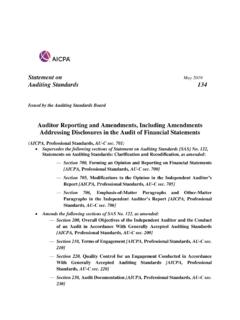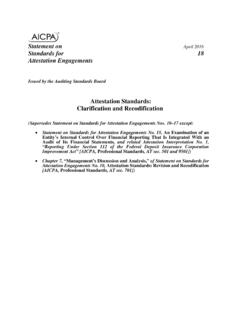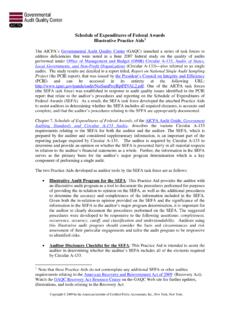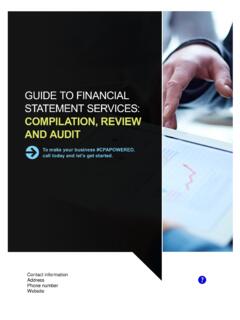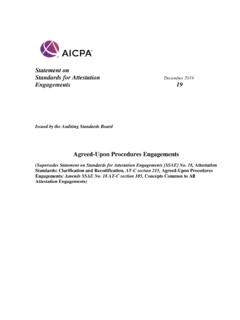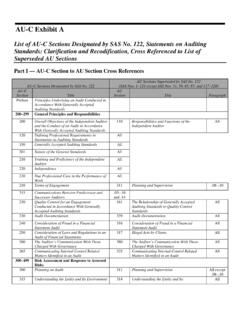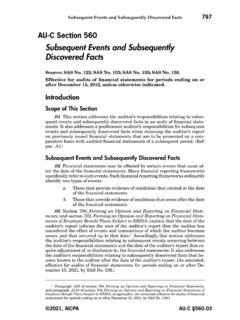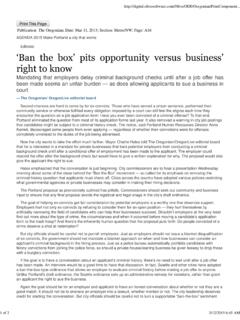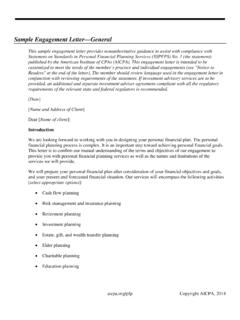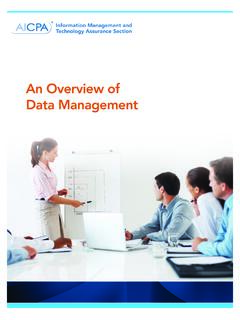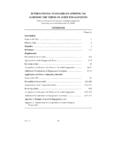Transcription of Summary of Differences Between Clarified SASs and ...
1 Reporting CenterFebruary 2014 Summary of Differences Between Clarified SASs and Superseded SASs In an effort to make generally accepted auditing standards (GAAS) easier to read, understand, and apply, the auditing Standards Board (ASB) redrafted all of the auditing sections in the Codification of Statements on auditing Standards to apply the clarity drafting conventions and to converge with International Standards on auditing (ISA). The codification of the Clarified standards uses section numbering established by SAS No. 122, Statements on auditing Standards: Clarification and Recodification, and contains AU-C section numbers instead of AU section numbers.
2 As part of the clarification of the SASs, the AU section numbers as designated by SAS Nos. 1 121 were recodified and AU-C was selected as an identifier in order to avoid confusion with references to superseded AU sections. Superseded AU sections were deleted from AICPA Professional Standards in December 2013, by which time substantially all engagements for which the AU sections were still effective were expected to be following table lists the Clarified Statements on auditing Standards (SASs) in AU-C section order. The table notes which AU section(s) each AU-C section superseded and summarizes the changes from the superseded AU reflect a more principles-based approach to standards setting, certain requirements that were duplicative of broader requirements within a superseded AU section were moved to application and other explanatory material within the Clarified SAS.
3 The ASB believes that this does not change the overall effectiveness of the Clarified SAS. Additionally, certain requirements that were in one superseded AU section may have been moved to a different AU-C section. The placement of these requirements does not create a difference Between the superseded SASs as a whole and the Clarified SASs as a whole. As of December 2010 (Revised February 2014) This analysis has been prepared by the Audit & Attest Standards team for informational purposes only. It is not authoritative and has not been acted on or reviewed by the auditing Standards of Changes200 Overall Objectives of the Independent Auditor and the Conduct of an Audit in Accordance With Generally Accepted auditing StandardsSupersedes: AU sections 110, 201, 210, 220, and 230 (SAS No.)
4 1, Codification of auditing Standards and Procedures, section 110, Responsibilities and Functions of the Independent Auditor, as amended; section 201, Nature of the General Standards; section 210, Training and Proficiency of the Independent Auditor, as amended; section 220, Independence; and section 230, Due Professional Care in the Performance of Work, as amended); AU section 120 (SAS No. 102, Defining Professional Responsibilities in Statements on auditing Standards); and AU section 150 (SAS No. 95, Generally Accepted auditing Standards, as amended).Changes From Superseded AU Sections:The Clarified SAS does not substantially change what is required of the auditor by the superseded AU sections.
5 However, the structure of the AU sections is changed by the Clarified SAS, and new terminology is Clarified SAS supersedes SAS No. 95, as amended, which contains the general, field work, and reporting standards (the 10 standards). The clarity drafting conventions adopted by the ASB include establishing an objective, or objectives, for each SAS. The Clarified SAS establishes the overall objectives of the auditor, which are obtain reasonable assurance about whether the financial statements as a whole are free from material misstatement,whether due to fraud or error, thereby enabling the auditor to express an opinion on whether the financial statementsare prepared, in all material respects, in accordance with an applicable financial reporting framework report on the financial statements, or otherwise as required by the SASs, in accordance with the auditor s explained in paragraph A71 of the Clarified SAS, each SAS contains an objective.
6 Or objectives, that provide a link Between the requirements and the overall objectives of the auditor. The SASs, taken together, provide the standards for the auditor s work in fulfilling the overall objectives of the auditor. If an auditor fulfills the overall objective of the auditor and meets applicable ethical requirements, such as the AICPA Code of Professional Conduct, the ASB believes that the auditor will have fulfilled the requirements previously stated in the 10 standards. The Clarified SAS introduces the terms financial reporting framework, applicable financial reporting framework, and fair-presentation framework.
7 210 Terms of EngagementSupersedes: Paragraphs .05 .10 of AU section 311 (paragraphs 5 10 of SAS No. 108, Planning and Supervision, as amended) and paragraphs .03, .05 .10, and .14 of AU section 315 (paragraphs 3, 5 10, and 14 of SAS No. 84, Communications Between Predecessor and Successor Auditors, as amended) Changes From Superseded AU Sections:Paragraph 6(a) of the Clarified SAS requires the auditor to determine whether the financial reporting framework to be applied in the preparation of the financial statements is acceptable. The auditor s responsibility for determining the acceptability of the applicable financial reporting framework, which is necessary in order to express an opinion on the financial statements, has been implicit in GAAS.
8 Thus, this change in requirements is not expected to affect practice, and it is appropriate that this determination be performed in conjunction with accepting the 6(b) of the Clarified SAS requires the auditor to obtain the agreement of management that it acknowledges and understands its responsibility for selecting the appropriate financial reporting framework, establishing and maintaining internal control , and providing access and information to the auditor. Paragraph .08 of superseded AU section 311 requires that the auditor should establish an understanding with management and requires that the understanding should include management s responsibilities.
9 Paragraph .09 of superseded AU section 311 includes management s responsibility for the selection and application of financial reporting, establishing and maintaining internal control , and making all financial records and related information available to the auditor as matters that may be included in the understanding established with the client. Thus, a level of detail that is suggested in superseded AU section 311 is required in the Clarified SAS. The ASB believes that it is appropriate require that management s responsibilities be explicit in the engagement letter because there is no point in starting an audit if management won t acknowledge its 7 of the Clarified SAS requires that if management or those charged with governance of an entity that is not required by law or regulation to have an audit impose a limitation on the scope of the auditor s work in the terms of a proposed audit engagement such that the auditor believes the limitation will result in the auditor disclaiming an opinion on the financial statements as a whole.
10 The auditor should not accept such a limited engagement as an audit engagement unless the audit is required by law or regulation. Paragraph 8 requires that, unless required by law or regulation to do so, the auditor should not accept the engagement if the auditor has determined that the applicable financial reporting framework is not acceptable or if the agreement referred to in paragraph 6(b) has not been obtained. Superseded GAAS does not contain these requirements. Thus, these changes in requirements affect 13 of the Clarified SAS requires the auditor to assess for recurring audits whether circumstances require the terms of the audit engagement to be revised.
